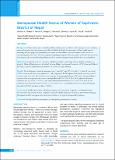Please use this identifier to cite or link to this item:
https://hdl.handle.net/20.500.14356/1708| Title: | Menopausal Health Status of Women of Kapilvastu District of Nepal |
| Authors: | Ghimire, N Dhakal, P Norrish, D Dangal, G Sharma, D Dhimal, M Aryal, K K Jha, B K Karki, K B |
| Citation: | GhimireN., DhakalP., NorrishD., DangalG., SharmaD., DhimalM., AryalK. K., JhaB. K., & KarkiK. B. (2016). Menopausal Health Status of Women of Kapilvastu District of Nepal. Journal of Nepal Health Research Council. https://doi.org/10.33314/jnhrc.v0i0.669 |
| Issue Date: | 2015 |
| Publisher: | Nepal Health Research Council |
| Article Type: | Original Article |
| Keywords: | Health Kapilvastu Perimenopause Premenopause Women |
| Series/Report no.: | Sep-Dec, 2015;669 |
| Abstract: | Abstract Background: Women face numerous health problems in their post-reproductive and menopausal years, includingissues such as pelvic pain, incontinence and obstetric fistula. In Nepal, the importance of these health issues isincreasing with the aging of the population, yet women are often unable to access adequate health care due toentrenched gender structures and misconceptions regarding menopause. This study aimed to describe the prevalenceof menopause, the associated health problems and their severity amongst women aged 40–60 years in Kapilvastu. Methods: A descriptive study was conducted in Kapilvastu district. Multi stage cluster sampling technique was adopted: Illakas of Kapilvastu were identified, then one Village Development Committee (VDC) from each Illaka ofthe district, and two wards from each of these VDCs, were selected randomly. Results:The median age of onset of menopause was 47 years (25th and 75th percentiles = 43 and 50 years), and >90% of women had entered menopause by 54. All symptoms in the Menopause Rating Scale were experienced to some extent by at least 30% of women, even amongst the premenopausal group. The most common problems experienced by menopausal women were: sexual problems (81.7%, 95%CI: 78.0-85.4), physical and mental exhaustion (81.5%, 95%CI: 77.8-85.2) and joint and muscular discomfort (78.5%, 95%CI: 74.6-82.4). The symptoms most frequently deemed “severe†or “very severe†were: sexual problems (40.5%), joint and muscular discomfit (27.4%), and sleep problems (21.0%). Conclusions: Middle-aged women in Kapilvastu experienced menopausal symptoms to a substantial degree.The prevalence and severity of these symptoms increased with the menopausal transition, and with increasing age. Menopause itself did not appear to be the primary risk factor for typical “menopausal†symptoms. |
| Description: | Original Article |
| URI: | http://103.69.126.140:8080/handle/20.500.14356/1708 |
| ISSN: | Print ISSN: 1727-5482; Online ISSN: 1999-6217 |
| Appears in Collections: | Vol. 13 No 3 Issue 31 Sep-Dec 2015 |
Files in This Item:
| File | Description | Size | Format | |
|---|---|---|---|---|
| 669-Article Text-1259-1-10-20160317.pdf | Full text Article | 182.85 kB | Adobe PDF |  View/Open |
Items in DSpace are protected by copyright, with all rights reserved, unless otherwise indicated.
